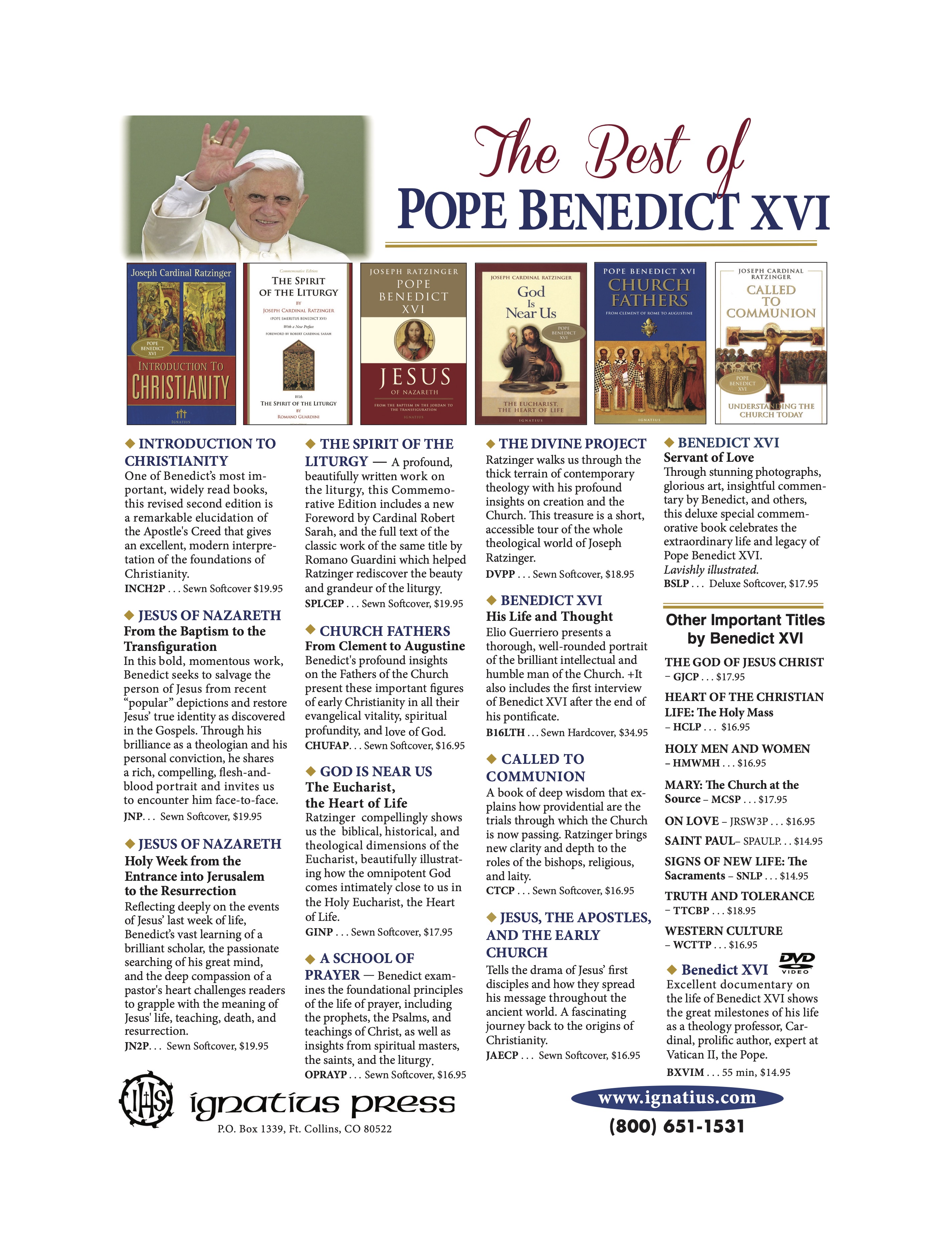AD: Get Free Access to Hallow App this Summer!
This is a paid advertisement in the April 2023 issue. To schedule a demo, scan the QR code below or email Hallow at [email protected].

AD: Books by Pope Benedict XVI
This is a paid advertisement in the April 2023 issue. To find out more about these books, go to https://ignatius.com or call 800-631-1531.

Inspired Through Art: The Annunciation by Jacopo Robusti (Tintoretto)
In 1583, nearing the end of a brilliant career as a painter, sixty-five-year-old Jacopo Robusti began work on The Annunciation, a scene of Gabriel announcing to Mary that she would be the mother of Jesus, the Son of God. Having grown up in his father’s dye business, Jacopo Robusti was better known as Tintoretto, the “little dyer,” from having drawn on the walls of the shop with pigments from his father’s dye pots. After absorbing the drawing style of Michelangelo and the color sense of Titian, he established a career in Venice. Tintoretto belonged to the group of Venetian painters known as Mannerists. Mannerism is a style characterized by exaggerations and unusual uses of color, light, and movement. As a mature painter, he also became known as Il Furioso—“The Furious”—for his energetic brushwork and powerful compositions, such as Paradise, an eighty-foot-long painting that is claimed to be the largest image ever painted on canvas. On a more moderate scale (13x17 feet!), Tintoretto’s The Annunciation is an example of how an artist can take what is conventionally seen as a quiet moment and turn it into a cosmic event. Tintoretto imaginatively, and correctly, transforms a well-known passage from Scripture into an exciting visual drama worthy of deep contemplation.
In the Gospel narrative, we are not given details of what Mary’s room in Nazareth was like, nor what Joseph was doing at the moment of the arrival of the Archangel Gabriel. Tintoretto gives us a significantly original point of view in which we see much more of the environment than expected. The side of the building facing us, the “fourth wall,” has been removed, which allows a broad expanse of space to be revealed. We get an “inside/outside” view of this moment and, at the same time, a vision of a needful world about to be transformed. Outside the house, the environment is dark, filled with broken boards in jumbled piles.
We can imagine this place as unkempt and disordered, a house and landscape that once was whole but now has fallen apart. This is a beautiful metaphor for the world as it was after the Fall of Adam and Eve. St. Joseph is in the distance working at some project alone in the darkness. The wall that separates the outside from the inside is itself a ruin of broken architecture. Mortar is peeling away from the brick wall. A piece of a classical column is topped with fragments of stones, bricks, and pottery—a haphazard stack of human designs that represent the failure of mankind to accomplish a true, beautiful, and lasting order. Mary’s room is tidy but also shows material poverty. The seat of the empty chair needs repair, and while the checkerboard of the floor depicts the order of classical perspective, it isshowing age and wear. But there is a glimmer of light on the horizon. Something is about to change—restoration and salvation are at hand. Christ will make all things new again.
The Spiritual Life: The Eucharist – Food of Truth and Source of our Salvation
 In a 1978 Lenten catechesis given in Munich, then-Cardinal Joseph Ratzinger spoke of the eucharistic mystery as an incomparable encapsulation of Christ’s transformative self-gift, whose meaning is best expressed in the act of washing his disciples’ feet: “He, who is Lord, comes down to us; he lays aside the gar
In a 1978 Lenten catechesis given in Munich, then-Cardinal Joseph Ratzinger spoke of the eucharistic mystery as an incomparable encapsulation of Christ’s transformative self-gift, whose meaning is best expressed in the act of washing his disciples’ feet: “He, who is Lord, comes down to us; he lays aside the gar
Encountering God in Catechesis: The Power of Prayer
 My husband and I met George a few years ago through Marriage Encounter. He was a navy pilot. While his wife was Catholic, George was not religious. We were George and his wife’s prayer couple during their weekend
My husband and I met George a few years ago through Marriage Encounter. He was a navy pilot. While his wife was Catholic, George was not religious. We were George and his wife’s prayer couple during their weekend
The Spiritual Life: Toward a Eucharistic Revival – The Real Presence of Jesus
The water is poured and the words are said: “I baptize you in the name of the Father, and of the Son, and of the Holy Spirit.” As I approach the newly baptized baby held in the arms of his mother or father, I bow, make the sign of the cross, and venerate (kiss) the child as I would an icon. Doing so, I venerate Jesus Christ present in this child. The child, having been washed of sin, filled with the Holy Spirit, and clothed in Christ, is now a holy image of him who is the perfect image of the Father.
As the child grows, the image may become tarnished, but it will remain. Just as a work of art is restored, so too the Sacrament of Reconciliation restores the image of Christ in us—washing away the grime and mending brokenness so that the light of Jesus Christ, truly present in us, may shine forth in the world.
“The Father and I are one. . . . Remain in me, as I remain in you” (Jn 10:30; 15:4). In the reception of the Holy Eucharist, our Lord, one with the Father in the unity of the Holy Spirit, comes into us in a wholly unique manner and draws us unfathomably within himself. The presence of Jesus Christ in the Holy Eucharist is of a completely different type than his presence elsewhere. It is substantial; it is of his essence. When we say that Jesus Christ is truly present in the Blessed Sacrament, what we mean is that the Blessed Sacrament is Jesus Christ. While the visible form of bread and wine remain, it is him—not a sign pointing to him, not an object that mediates grace (e.g., a miraculous medal, the brown scapular)—it is Jesus himself.
AD: School of Spiritual Direction Accepting Applications! Is God calling you?
Is God calling you to spiritual direction? To learn more or to apply, click here or call 740-283-6402. The next new Summer Instensive Program (3-year program) will be held on our beautiful campus in Steubenville, Ohio July 16-29, 2023.
AD: Illuminating Works on the Power of God's Love
This is a paid advertisement in the October-December 2022 issue. Advertisements should not be viewed as endorsements from the publisher. To find out more about these books, go to https://ignatius.com or call 800-631-1531.

Catholic Schools: The Paschal Mystery Time Machine – Teaching Time to Teens

What do the films A Wrinkle in Time, Back to the Future, The Terminator, Interstellar, and Avengers: End Game have in common? They all tap into our innate fascination with time travel. If you could travel through time, where in history would you go? Who would you visit? What would you alter for the sake of the future?
These are strategic questions I use to open the lesson on the sanctification of time. With this exercise, students are first invited into the time machine of their own memory and imagination. After this discussion, I pre-teach some basic doctrinal points about time:
- Time is created by God with a beginning and an end.
- Chronos time is time that we can measure and keep track of with calendars and clocks.
- Kairos time is time from God’s point of view. It is all of time at once in one “eternal now.” Eternity.
- The Eastern concept of time is cyclical. This is how beliefs such as karma and reincarnation emerged.
- The Western concept of time is linear and it has a telos or an end. It is progressing toward the future.
- We can think of the liturgical year as a spiral that is simultaneously cyclical and linear or advancing toward an end.
- Jesus, the Eternal Word, is timeless. (CCC 525)
- The Paschal Mystery changes how we experience time.
The fourfold event of Jesus’ Suffering, Death, Resurrection, and Ascension was so impactful and powerful that it reverberates through time in every direction. It hit history so hard that it broke it in two; that which came before Christ (BC) and that which began with Christ (AD). In the Old Testament, the Paschal Mystery is prefigured through typology and prophecy. In the age of the Church, it is echoed forward in the liturgical calendar. In the sacraments, the Paschal Mystery transcends time. The sacraments are, in a way, the only known means of time travel. When we remember our story and enter into it in the sacraments, we are entering into a dimension of time that is not stuck in the past, present, or future, but envelopes all of it. This is because, unlike any other religious figure, Jesus is not just a person of history. He is alive and actively encountering his people with his life-giving, saving love.
Inspired Through Art: Living the Mysteries of Christ in the Mysteries of Mary

“Mary does bring us closer to Christ; she does lead us to him provided that we live her mystery in Christ,” wrote St. John Paul II.[1] Throughout the year, the Church offers the faithful countless spiritual paths to live in the mystery of Christ through the feasts and fasts, the seasons and rhythms of the liturgical year. Manifold dimensions of the Paschal Mystery of Jesus’ Life, Passion, Death, and Resurrection unfold in time across the liturgical year. In this way, each day of the liturgical calendar is a renewed opportunity to enter into the life of grace and communion with the Blessed Trinity, who permeates time through the liturgical year to sanctify and transfigure human history.
The Catechism of the Catholic Church notes, “In celebrating this annual cycle of the mysteries of Christ, Holy Church honors the Blessed Mary, Mother of God, with a special love. She is inseparably linked with the saving work of her Son. In her the Church admires and exalts the most excellent fruit of redemption and joyfully contemplates, as in a faultless image, that which she herself desires and hopes wholly to be.”[2]
Contemplation of the mysteries of the life of the Blessed Virgin Mary lead the faithful into contemplation of the mystery of Jesus Christ, her divine Son. A beautiful Netherlandish altarpiece, titled The Fifteen Mysteries and the Virgin of the Rosary, places before our eyes the life of Jesus Christ and his mother Mary so we might imitate her example and experience her spiritual motherhood of the Church. The masterpiece image also invites us to renewed devotion to the Marian prayer of the Rosary, as the Church celebrates the Memorial of Our Lady of the Rosary each year on the seventh of October.


